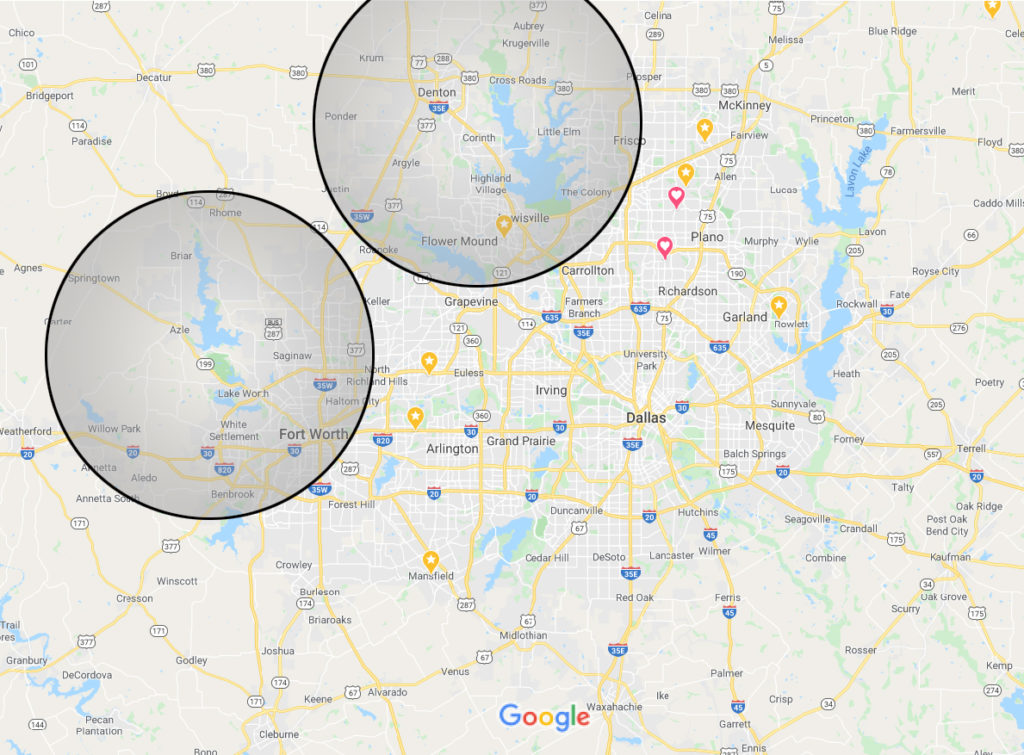
High risk zones for emerald ash borer based on known locations where the borers are established. May 2020. Circles show the areas within 15 miles of known EAB infestations; any ash trees of value within these circles should be treated this year to ensure protection from attack.
When Denton urban forester Haywood Morgan moved to Texas from Milwaukee, Wisconsin six years ago he thought he was leaving the devastating emerald ash borer behind. Instead the ash borer found him again.
Morgan became reacquainted with EAB this month during a trip to look at some sick ash trees along a Denton, Texas street. After inspecting ash borer-like damage on the 11 year old ash, his experienced eye caught a glimpse of shiny green. A quick grab and he had it–what appears to be the first emerald ash borer to be found in Denton county.
According to Morgan the insects appear to have been in this neighborhood for several years, based on extensive damage seen to a half dozen or so ash trees.
Arborist Scott Geer with Tree Shepherds also visited the site. In addition to the landscape trees around the house Morgan inspected, Geer reported other neighbors with damage, as well as damaged native green ash in an adjacent forest.
“Ash are not the predominant tree in Denton County,” said Geer. “Green ash are found in pockets, mostly along the creeks; but Denton county is dominated by post oak, blackjack oak and cedar elm with some ash scattered in pockets.”
The emerald ash borer attacks ash trees almost exclusively*, so non-ash tree species will be safe.
The insect Morgan collected has been sent to USDA experts for official verification, but everyone who saw the insect was convinced.
This makes the second active EAB site in the Dallas/Fort Worth metroplex, but the first in an urban neighborhood in Texas.
Most tree experts agree that emerald ash borer may be the most important exotic tree pest to enter the country since chestnut blight, which caused the near-extinction of wild chestnut trees in the U.S. This beetle may be nearly as devastating, with some experts worrying that die-back of natural populations could threaten extinction for the 15-plus species of native ash in the U.S.
Damage to trees is not immediately visible as the beetles typically start their attack at the top of the tree. Symptoms to look for include canopy thinning in the upper tree, bark splitting, and sprouting or vigorous new growth from the ground and lower portions of the tree. Only later will the 1/8 inch, D-shaped emergence holes of the beetle be visible.
If you suspect your ash tree has symptoms of the borer you will need to either treat it, if damage is not severe, or cut it down. Borer damaged trees quickly dry out and become brittle, making them hazardous to people and property. Local tree care companies have treatments that will provide 2-3 years of protection against the borer. Do-it-yourself treatments are also available from garden centers. They involve drenches with insecticides containing imidacloprid, azadirachtin or dinotefuran. Home treatments must be reapplied annually.
For more information on EAB, it’s ID, biology and control, go to http://www.emeraldashborer.info/ Also, reports of suspected EAB may be submitted through the Sentinel Pest reporting function of the Texas Invasives website. Experts from USDA there are ready to evaluate samples, but keep in mind some simple guidelines for sending in pictures. For more information about how to recognize EAB damage, check out this guide.
Insect Updates will keep you informed about continued spread of EAB through the Dallas/Fort Worth area.
* Cases of EAB attacking Chionanthus virginicus (white fringetree) have also been documented.

